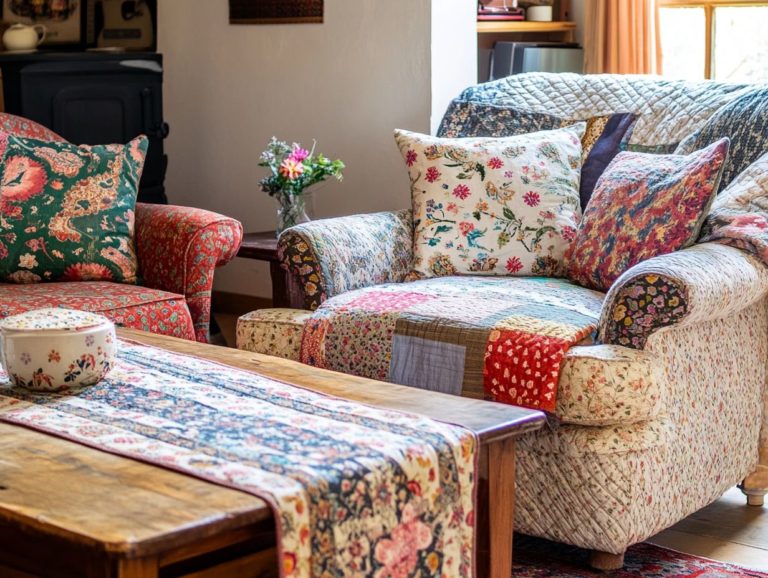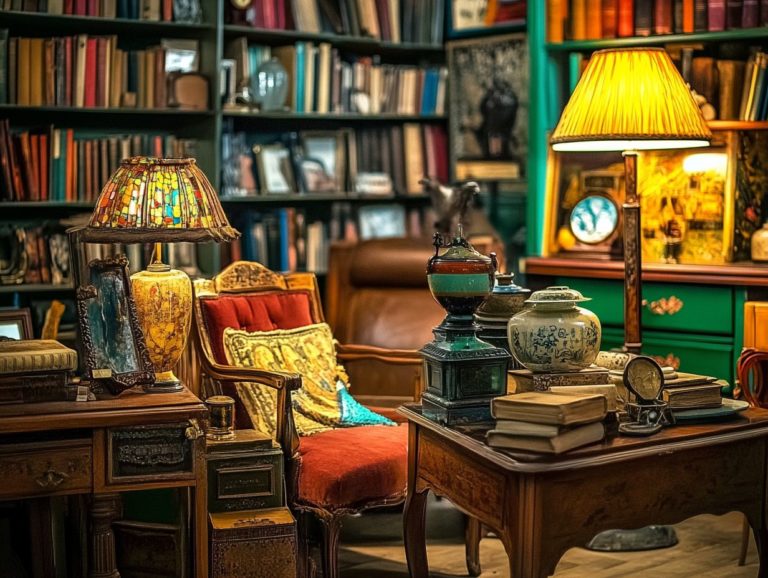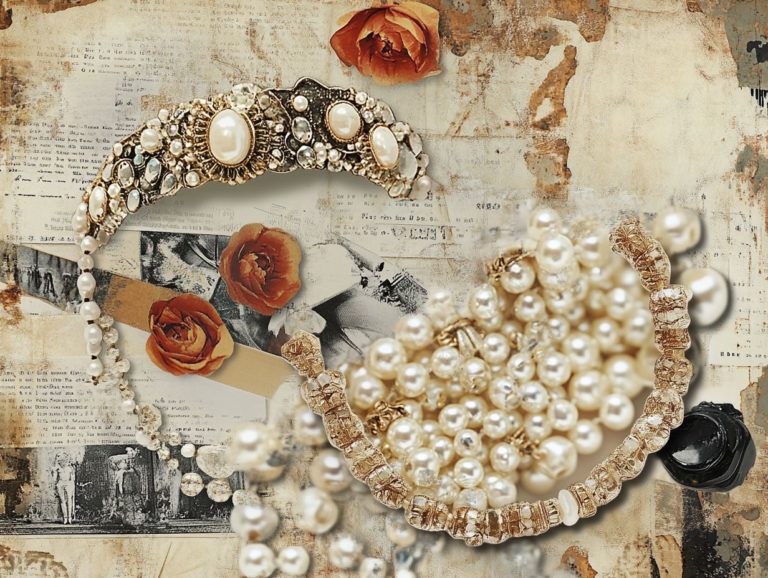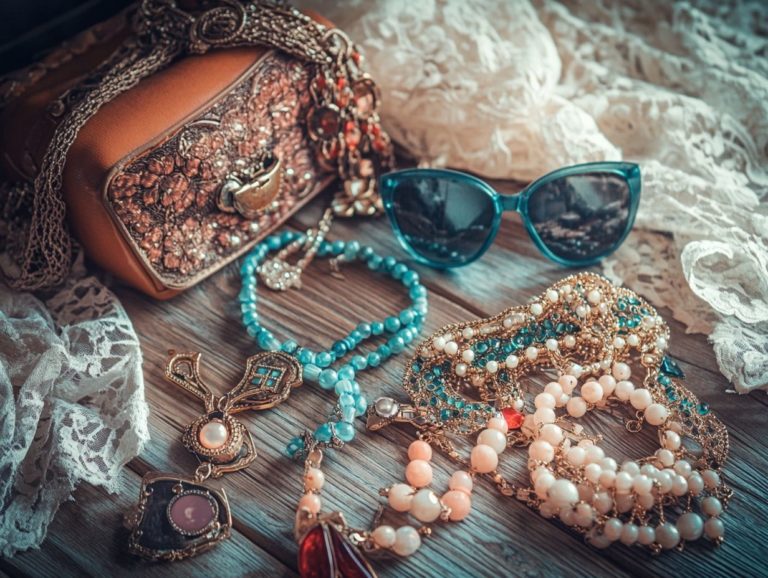How to Identify Authentic Vintage Collectibles
Ready to unlock the secrets of vintage collectibles? Vintage collectibles have a unique ability to evoke nostalgia, tell captivating stories, and even present intriguing investment opportunities.
But what truly sets an item apart as “vintage”? Understand the age, condition, and rarity that define collectibles.
This guide will delve into the key factors that influence authenticity, equip you with valuable research tools, and spotlight common types of collectibles you may encounter.
You’ll discover how to identify fakes and uncover best practices for preserving and showcasing your prized possessions.
Whether you re a seasoned collector or just starting your journey, this guide is designed to empower you as you navigate the fascinating realm of vintage collectibles with unwavering confidence.
Contents
- Key Takeaways:
- Understanding Vintage Collectibles
- Factors that Affect Authenticity
- Researching and Identifying Authenticity
- Common Types of Vintage Collectibles
- Tips for Spotting Fakes
- Preserving and Displaying Vintage Collectibles
- Frequently Asked Questions
- 1. What is considered a vintage collectible?
- 2. How can I determine if a vintage collectible is authentic?
- 3. What are some key features to look for in authentic vintage collectibles?
- 4. Are there any common red flags to watch out for when identifying vintage collectibles?
- 5. Can I use online marketplaces to purchase authentic vintage collectibles?
- 6. Are there any resources available to help with identifying and authenticating vintage collectibles, such as America s Antique Mall in Highland, Indiana?
Key Takeaways:
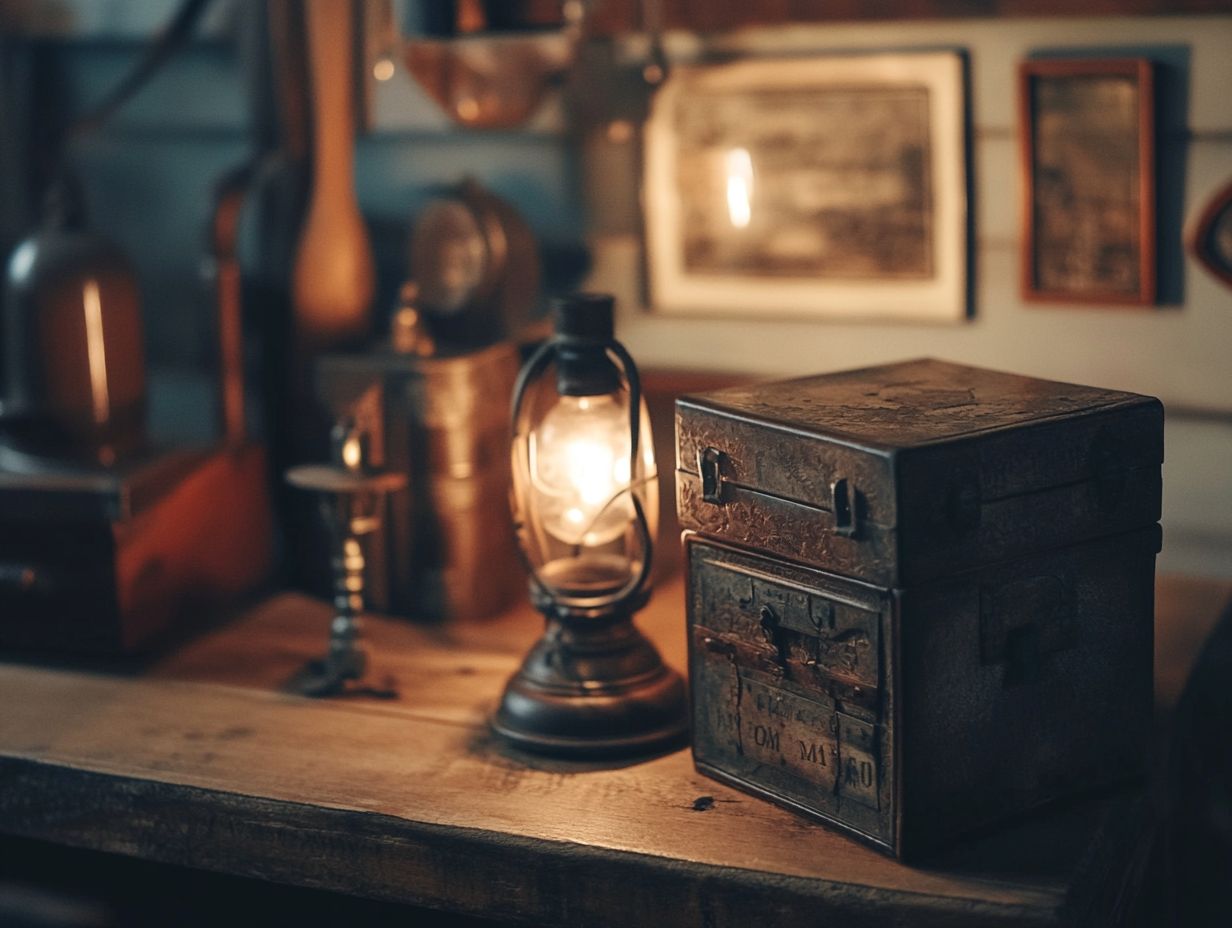
- Authentic vintage collectibles are at least 20 years old and are defined by their condition and rarity.
- Use reliable research tools to ensure you re making wise investment choices.
- Learn to spot red flags to avoid fakes and preserve your vintage treasures.
Understanding Vintage Collectibles
Understanding vintage collectibles invites you to explore a captivating realm filled with items that evoke nostalgia and encapsulate our shared past. From rare baseball cards and comic books to charming childhood toys and Pok mon memorabilia, these collectibles serve as a bridge to your youth while also presenting valuable investment opportunities in today s market.
The pursuit of vintage items has surged in popularity, as enthusiasts like you seek out unique treasures that not only tell stories but also hold significant sentimental value. Whether it’s sports memorabilia or antique dolls, the vintage collectibles landscape offers a rich tapestry woven with history and passion. To truly appreciate these pieces, learning how to identify authentic vintage wall art is essential, appealing to collectors of all ages.
Defining What Makes an Item ‘Vintage’
Defining what makes an item ‘vintage‘ hinges on its age, quality, and uniqueness elements that often echo a specific era, captivating collectors and enthusiasts alike. Vintage collectibles are typically at least 20 years old and boast distinctive features that set them apart from their modern counterparts.
In terms of categorizing an item as vintage, consider crucial factors such as rarity, condition, and the story it brings from its original time period. For instance, antique furniture crafted in the early 20th century not only showcases exceptional craftsmanship but also carries significant historical weight. To ensure you’re making informed choices, learn how to identify reproductions with our guide on vintage furniture.
Similarly, rare coins minted decades ago, with unique markings or limited production runs, transform into prized possessions for coin collectors. First edition books, especially those with original dust jackets and author signatures, command premium prices, particularly when they re in mint condition. Collectors cherish these items not merely for their visual appeal but for the rich narratives woven into their very fabric.
Factors that Affect Authenticity
When exploring the realm of vintage collectibles, understand that authenticity hinges on age, condition, and rarity. These elements are critical in establishing an item’s genuine value and the interest it garners from collectors.
Authenticity is crucial for everyone involved in vintage collectibles, as it safeguards the integrity of your investments. Therefore, understanding these factors is essential as you navigate the market and make informed decisions.
Age, Condition, and Rarity
Age, condition, and rarity are vital factors when determining a collectible’s authenticity. They significantly influence its desirability and market value.
As a collector, you know these factors are crucial when curating your collection. Items that exhibit age, excellent preservation, and rarity often command higher prices in the marketplace.
Take comic books, for instance. A first edition from the 1960s in mint condition is not just a nostalgic artifact; it s a valuable investment that can reach astonishing prices at auctions due to its age and condition.
Similarly, consider rare coins, like a vintage 1909-S V.D.B. penny. This illustrates how rarity and condition interact to create astronomical valuations. Fewer coins in pristine shape lead to increased demand among coin collectors.
In both examples, these factors work together to establish authenticity and value, highlighting why you, as a collector, should stay vigilant about preserving your prized treasures.
Researching and Identifying Authenticity

Researching and identifying authenticity in vintage collectibles is crucial for serious collectors like you. It requires a keen eye and access to trustworthy tools and resources.
Provenance, expert appraisals, and thorough research can help you verify the authenticity of desired items, whether they are Pok mon memorabilia or rare coins.
Tools and Resources for Verification
Using the right tools for verification is essential for establishing the authenticity of vintage collectibles. This ensures you are truly investing in genuine treasures.
To navigate this complex landscape, rely on reputable authentication services that provide expert evaluations and certificates confirming the legitimacy of your items.
Professional grading organizations often offer a grading scale to help you understand not just authenticity but also the condition of your collectibles.
Online databases, such as those maintained by auction houses, are invaluable for cross-referencing items against known fakes. Seek advice from seasoned collectors or participate in forums to uncover specific details that distinguish genuine pieces from replicas.
By utilizing these resources, you can make informed decisions and significantly enhance the value of your collection.
Common Types of Vintage Collectibles
Vintage collectibles encompass a captivating range of items that attract both enthusiasts and serious collectors. You may find yourself drawn to baseball cards, comic books, sports memorabilia, or even cherished LEGO sets.
This rich diversity in collectibles not only reflects various interests but also imbues each category with its unique charm and market value, making the pursuit of these treasures all the more rewarding.
Antiques, Memorabilia, and More
Antiques, memorabilia, and vintage collectibles each hold a special place in the hearts of collectors, weaving unique stories into the fabric of history and culture.
Whether it’s sports collectibles celebrating legendary athletes or nostalgic items evoking cherished memories, these treasures resonate with enthusiasts like you. If you’re interested in how to identify high-quality vintage fabrics, these items can also enhance your collection.
They span various categories to cater to diverse interests. For example, antique furniture showcases craftsmanship from bygone eras, while collectible coins offer intriguing tales of currency evolution. Vintage toys like classic action figures or beloved board games ignite fond memories of childhood adventures. If you’re interested in furniture, learning how to spot quality vintage furniture can enhance your collection.
In the realm of memorabilia, music lovers may treasure vinyl records that capture iconic moments in pop culture. These items not only serve as tangible links to the past but also guide you on an engaging journey through personal and collective history.
Tips for Spotting Fakes
Spotting fakes in the vintage collectibles market is an essential skill for collectors. Counterfeit items can undermine both the integrity of your collection and the value of your investments.
By recognizing red flags and warning signs, you can navigate the market with enhanced confidence, ensuring your passion for collecting remains rewarding and secure.
Engage actively in the collecting community and utilize the resources mentioned to further enhance your skills!
Red Flags and Warning Signs

Identifying red flags and warning signs is essential for spotting fakes among vintage collectibles. These cues can often indicate compromised authenticity and value, so you should remain vigilant for discrepancies in materials, craftsmanship, and provenance (the history of ownership of an item, which can affect its authenticity and value). These factors frequently unveil the true nature of an item.
Take vintage jewelry, for example. If you notice a mismatch in the type of metal used or unusual gemstone settings, it could be a reproduction. For rare coins, the absence of expected mint marks or irregularities in weight may very well suggest forgery. In terms of vintage toys, examining paint quality, logos, and packaging can reveal questionable origins. Additionally, when it comes to furniture, knowing how to identify authentic vintage furniture is crucial to avoid being misled.
Understanding an item s history is crucial; any inconsistency in its documented lineage should raise a red flag. For collectors eager to protect their investments, learning about these warning signs is essential!
Preserving and Displaying Vintage Collectibles
Preserving and showcasing vintage collectibles is crucial for maintaining their condition and elevating their aesthetic appeal. This allows these treasured items to be cherished for generations.
By employing effective care and maintenance strategies, you can significantly extend the lifespan of your collectibles, whether it’s antique furniture or rare Pokémon memorabilia. Additionally, if you’re interested in collectibles like lighting, it’s useful to learn how to identify authentic vintage lighting.
Best Practices for Care and Maintenance
To care for and maintain vintage collectibles, it’s essential to grasp the unique requirements of various items whether they are comic books, antique dolls, or collectible toys. Implementing effective preservation techniques is vital for safeguarding their condition and ensuring they retain their value over time.
For comic books, storing them in acid-free bags and keeping them upright in a cool, dry environment is key to preventing fading and moisture damage. Always handle them with clean, dry hands or gloves to avoid transferring oils that could harm them.
Antique dolls require extra care. Keep them away from direct sunlight and fluctuations in temperature, as these elements can lead to fading and deterioration. Using non-abrasive cleaning tools and specialized doll care products can help maintain their beauty and integrity. Paying close attention to these details is crucial for any dedicated collector.
Frequently Asked Questions
Here are some common questions about vintage collectibles:
1. What is considered a vintage collectible?
A vintage collectible is typically an item that is at least 20 years old and holds value due to its age, rarity, and historical significance.
2. How can I determine if a vintage collectible is authentic?
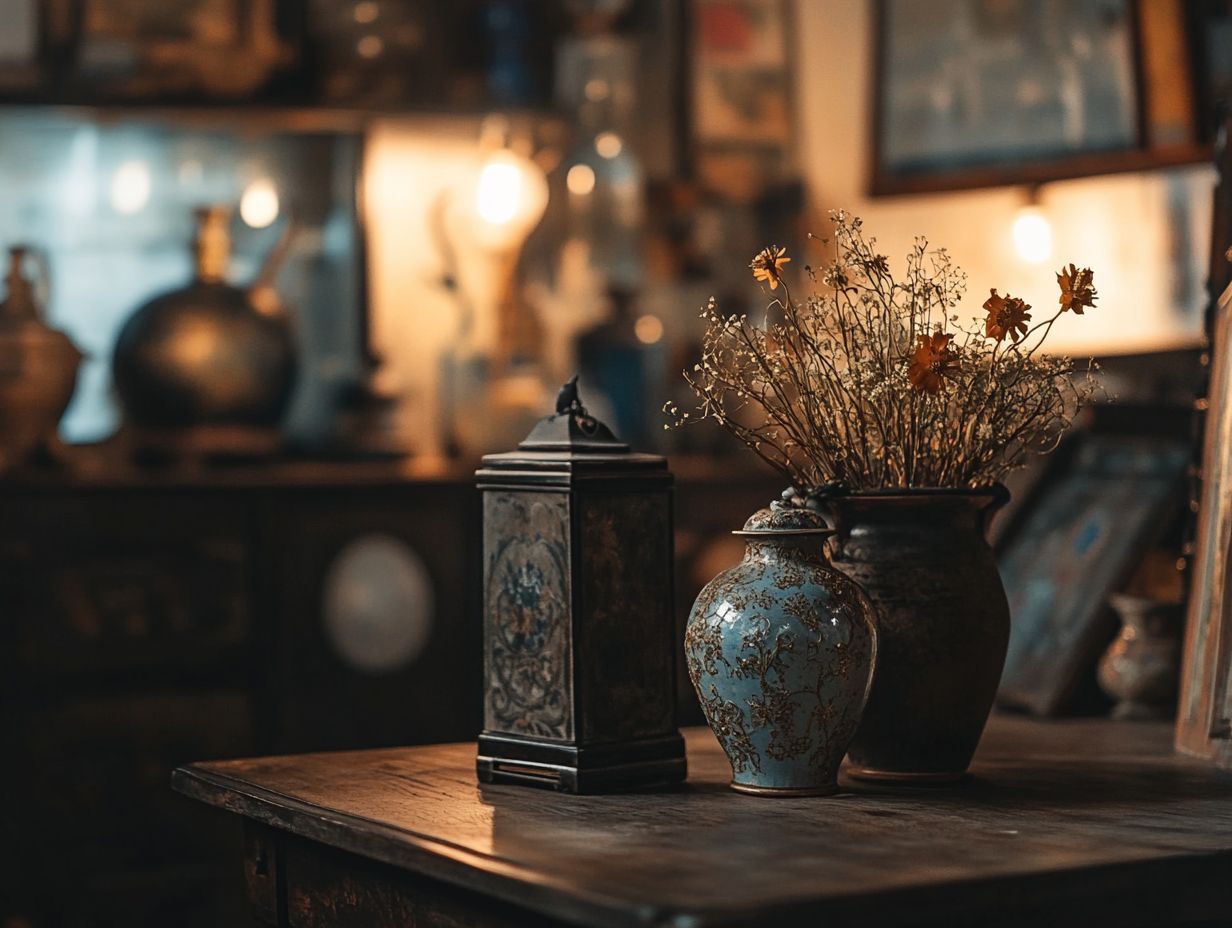
One way to identify the authenticity of a vintage collectible is to research its history, manufacturer, and production methods. You can also consult with experts or use reference materials to compare and verify its features.
3. What are some key features to look for in authentic vintage collectibles?
Authentic vintage collectibles often have unique and distinct features that set them apart from modern or replica items. These may include specific markings, materials, and production techniques that were used during the time period the collectible was made.
4. Are there any common red flags to watch out for when identifying vintage collectibles?
Some red flags that may indicate a vintage collectible is not authentic include missing or incorrect markings, poor quality materials or craftsmanship, and inconsistencies in design or production methods.
5. Can I use online marketplaces to purchase authentic vintage collectibles?
While online marketplaces can be a convenient way to find vintage collectibles, it is important to do your research and be cautious of potential scams. Always verify the seller s credibility and thoroughly examine photos and descriptions before making a purchase.
6. Are there any resources available to help with identifying and authenticating vintage collectibles, such as America s Antique Mall in Highland, Indiana?
Yes, several resources can help you. These include books, online forums, and collectible clubs.
You can talk to appraisers or experts in the vintage collectibles you like. Exploring these resources can be thrilling. You ll find amazing treasures and connect with passionate collectors!


